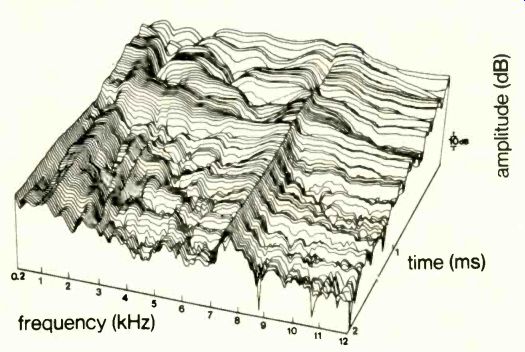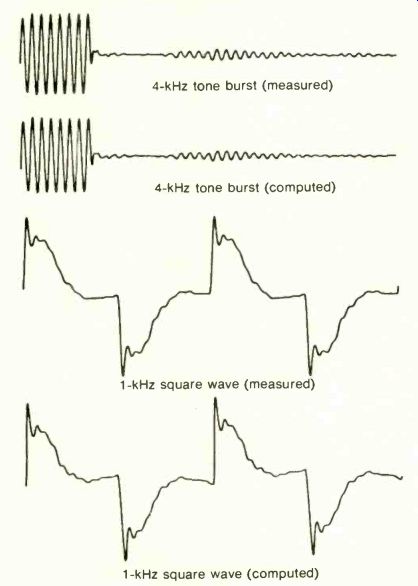by Harold A. Rodgers
[Harold A. Rodgers is HF's Associate Audio-Video Editor]
IF THE CONTEMPLATION of computer-aided design applied to speakers and speaker systems fills your mind with terrifying images of some 2001 in which a malevolent HAL conjures up components suited to the taste of mechanical (tin?) ears, you can re lax. That's not the way it is at all. The most important decisions made by the designer of a piece of audio gear are musical and psychoacoustic-and barring radical changes in the nature of human hearing, they are likely to remain so. And since matters of this type are not particularly amenable to mathematical solution, of what use, you may ask, is the computer?

--------- Cumulative decay spectrum shows how amplitude (vertical axis)
falls off with time (back-to-front) at frequencies from 200 to 12,000 Hz
(left -to -right) after speaker is excited by an impulse, and summarizes
all tone -burst responses across that bandwidth. The ridge near 7 kHz is
a characteristic resonance of the system under test.

---------- Measured responses vs. computed responses
To answer that, it is necessary to realize that, in comparison with electronics, loudspeakers which are more complex to begin with-are in a relatively primitive state of development. Consider, for example, a power amplifier. Generally, it is not too hard to make one whose response curve is flat across the audio band-plus, often, a large safety margin--give it almost any maximum power we choose, and make its distortion negligible (although the criteria for what is negligible have become ever more stringent through the years). But things are not so simple when we design a speaker.
We cannot within practical limits of cost and size design for the total audio bandpass plus a safety factor (certainly not with flat response) nor can we reduce distortion to negligible levels--and if high power output without sacrifice of bandpass is important we come rather quickly to the question of efficiency. What this all means is that it is necessary to juggle literally dozens of interacting parameters and put the glitches where they will do the least audible harm. The computer can be of much help in defining physical limits, providing that the interactions can be described in mathematical terms.
Let's take a peek into a speaker design lab and watch how a computer helps an engineer analyze a woofer. The first step is to activate the computer and answer its "housekeeping" questions about the date, ambient temperature, height above sea level, and barometric pressure. When this has been done, the machine poses a series of questions concerning the driver under test, such as: "How is the driver identified? Is the driver connected to the test apparatus? Is the driver in free air?" This continues until all necessary conditions are satisfied; a portion of the test is then run and the data stored by the computer. Then some more questions: "Is the driver mounted on a box? What are the dimensions of the box?" Once the engineer has typed in acceptable answers to these and a few other questions, the test proceeds. In a few seconds, the computer types out a table of alignments--basic relations between the woofer and its enclosure classified in terms of applicable filter theory-giving enclosure volume, cutoff frequency, dimensions of the vent (if any), electrical source resistance, and other parameters.
This is a somewhat simplified description of a system that has been used by Dr. J. Robert Ashley of the University of Colorado (who acted as design consultant for the Koss CM series) and others. Its beauty is that it tells the designer exactly what can be gotten from a particular woofer-and how to get it. He need only decide what he wants; the computer does all the busywork.
Another notable use of the computer, pioneered by KEF Electronics of England, is in determining the response of a speaker to an impulse of very short duration. The measured data from such a test give information not only about transient response and time dispersion, as might be expected (see Peter Mitchell's article), but about frequency response as well. The problem in making this measurement has been that, in order that the test pulse contain the full range of audible frequencies, it must be very short and, therefore, will contain little energy, even when its amplitude is made rather large. This, in turn, means that the signal-to-noise ratio available for the test is poor.
Computer analysis solves this nicely by having the processor repeat the test many times, typically from 64 to several hundred (which a human tester could not do without horrendous tedium and probable error), and average the results, thereby lessening the noise component. Since an impulse response can be interpreted as equivalent to all possible tone-burst responses (the response to any tone burst, square wave, or other signal can be computed from the impulse response), the data is sometimes displayed as a three-dimensional plot of amplitude, time, and frequency that shows how each frequency component decays with time.
Interestingly, the impulse response for a multi-way system is the sum of the impulse responses of the individual drivers, provided that correction is made for their relative positions and for the crossover network. Thus, if a library of impulse responses of existing drivers is kept, it is possible to model entire speaker systems via the computer.
Variants of this technique are used by companies as diverse as B&W Loudspeakers and Acoustic Research and, of course, by KEF.
These examples do no more than scratch the surface. The possibilities of computer-aided de sign applied to loudspeakers are vast. The limits that exist are in areas (such as room interactions) where precise mathematical models either do not exist or cannot be made sufficiently general to be useful. (For what room shall the model be made?) It is not precisely true to say that computers make it possible to do things that are impossible otherwise: In principle, what can be done with a computer can be done without one. The reality is more nearly that computers can make practicable endeavors that are otherwise impracticable. To the consumer this will mean ultimately that more performance is available from a loudspeaker, and at lower cost, than otherwise.
-------------
(High Fidelity, Oct. 1977)
Also see: